A History of the County of Worcester: Volume 3. Originally published by Victoria County History, London, 1913.
This free content was digitised by double rekeying. All rights reserved.
'Parishes: St John in Bedwardine', in A History of the County of Worcester: Volume 3, (London, 1913) pp. 501-510. British History Online https://www.british-history.ac.uk/vch/worcs/vol3/pp501-510 [accessed 26 April 2024]
In this section
ST. JOHN IN BEDWARDINE
The parish of St. John in Bedwardine, containing about 3,775 acres, of which 901 are arable, 1,745 under permanent grass and 99½ woods and plantations, (fn. 1) lies on the right bank of the Severn and stretches up the Teme, which forms its southern boundary from its junction with the Severn, as far as Cotheridge. On the north it is bounded by Broadheath, the Tenbury road and a tributary of Laughern Brook. (fn. 2) The chief roads, those from Worcester to Great Malvern, Hereford, Bromyard and Tenbury respectively, are old roads, and so apparently is the by-road to Oldbury; these are all mentioned in the court rolls of the 14th century, when the bridges by which some of them were carried over Laughern Brook and the Teme seem to have been in a state of chronic insecurity. (fn. 3) The Worcester, Malvern and Hereford branch of the Great Western railway passes through the parish, but there is no station nearer than Henwick.
The western part of the parish is made up of the hamlets of Upper and Lower Wick; the latter and part of the former were once parcel of the manor of Wick Episcopi. (fn. 4) 'A house with its garden and curtilage … and two fish ponds' is mentioned as early as 1299. (fn. 5) At Wick the Bishops of Worcester had a manor at which Godfrey Giffard often stayed, and where he entertained Archbishop Winchelsey in 1300. (fn. 6) He seems to have spent a good deal on building; the money, according to the Worcester monks, had been stolen from the sacrist of the priory, but apparently their judgement was warped by the joy of condemning a fault-finder. (fn. 7) The house now standing on the site known as Wick Episcopi is a U-shaped building, but nothing except the foundations is older than the 16th century. The present house at Lower Wick is modern, but has an extensive moat on the south. Standing in the farmyard is an ancient building long used as stables, which, it is claimed, is the remains of the church of St. Cuthbert. It is a rectangular building, probably of the early 13th century, built of red sandstone ashlar. The walls have been taken down to within about 5 ft. of the window sills and a half-timber and brick story erected upon them in the 17th century. The western portion of the south wall seems to have been rebuilt. The east and west windows are blocked, but the north external jamb of the latter, probably a lancet, has a filleted edge roll, and the internal jambs of the east window seem to have been similarly enriched; internal chamfered jambs of north and south windows remain, and on the old portion of the south wall there are two original buttresses. It is possible, however, that the building may be that of a small house having a hall and two-storied block at its east end.
There are at Upper Wick several 17th-century half-timber cottages with thatched roofs and some 18th-century brick ones with tiled roofs. Upper Wick manor-house to the west is an L-shaped brick building of about 1700, with a slightly later addition on the south. It is of two stories with an attic. The house has been somewhat modernized internally, but retains some old beams and the upper part of a fine oak stairway of the original date which has square newels with ball finials, heavy moulded handrail and twisted balusters. A long, narrow pond extending round the south for some distance was probably a moat.
On the western side of the parish, where the Malvern road crosses the Teme, is Powick Old Bridge. The two arches of the bridge on the St. John's side were broken down during the Civil War and subsequently rebuilt. (fn. 8)
Rushwick, which is first mentioned about 1299, (fn. 9) lies on the Hereford road between Laughern Brook and the Teme. A branch lane connects this hamlet with the Bromyard road, which it joins a little to the northeast of Crown East Court. The road here passes between the Grove Covert and Crown East Wood, at the western edge of which the ground after sloping steadily upwards from the Teme bank reaches the highest point in the parish; hence perhaps the name of the place, properly Crow Nest. (fn. 10) This ridge is well set with trees, for the greater part of the woodland in the parish lies about Crown East and Oldbury, though there is a strip of wood at Broadheath, and Birchen Grove, once the property of the Precepoor of Balsall (co. Warw.), (fn. 11) is still to be seen near the northern boundary of Temple Laughern. The coil is alluvium, the subsoil Keuper Marls. The common fields at Upper Wick were inclosed in 1789. (fn. 12)
The following place-names occur in local records: Portstraet (fn. 13) (x cent.); Nonham, Buttemefield, Bromlingfield, Colewyke, Chirnemore, Pitemauston, Pyrefield (fn. 14) (xiii cent.); Croppecroft, (fn. 15) Prichescroft, (fn. 16) Kynaresfelde or Kynewardesfelde, Sleyhull, Eorthenbrugge, Hurdelemebrugge and Noggensbrugge (fn. 17); Boddecroftesend, Pullestrete or Poelstret, Cloptones lone, (fn. 18) Blakefield, Doddecroft and Clokhull (fn. 19) (xiv cent.); le ffortey, Russhwycrosse or Rushwyke Crosse and Waterelone, (fn. 20) Leystonesfelde, Ladycroft, Dynes Grene, Standefast Brigge, Barewardyn and Parok Diche (fn. 21) (xv cent.); Kychyns, Moncke Orchard, Le Mytre, Leighton Corte (fn. 22) (xvi cent.); Pool Close and Sling Meadow (fn. 23) (xvii cent.).
MANORS
The manor of WICK EPISCOPI (Wiche, xi cent.; Wyke, xii cent.; Wyke by Worcester, xiii cent.; Wyke Episcopi, xiv cent.) belonged to the church of Worcester before the Conquest, (fn. 24) and its site is said to have been granted by Offa, King of the Mercians, to Bishop Milred before 775. (fn. 25) It continued to be held by the Bishops of Worcester until 1558, (fn. 26) when Queen Elizabeth assumed possession of it during a vacancy of the see under the Act of 1558, (fn. 27) after which it was held on lease from the Crown by Richard Maye till 1586. (fn. 28) In that year the queen granted it to Sir Thomas Bromley, (fn. 29) whose descendants (q.v. in Holt) remained in possession of Wick until 1743, (fn. 30) when Henry Lord Montfort sold the larger part of the estate to Richard Vernon, (fn. 31) who was probably a trustee for Thomas Vernon of Hanbury, for the latter was in possession in 1745. (fn. 32) Other parts were sold by Lord Montfort to William Bund. (fn. 33) The Vernon part followed the descent of Hanbury (fn. 34) until recently, when the greater part was sold to the tenant, Mr. John Edward Powell. (fn. 35)
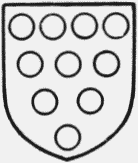
Bishopric of Worcester. Argent ten roundels gules.
It was the custom of the manor of Wick Episcopi as well as the other manors belonging to the see that the demesne lands should be let by indenture and convent seal and all other tenantries of copyhold by court roll. (fn. 36) In the 15th century some of the parishioners obtained the convent seal for the purpose of making fraudulent indentures 'by which the bishop looses his heriots and fines and the King's pore subjects hath no habytacons' (fn. 37); a commission of inquiry was appointed, with the result that the culprits were commanded to appear before the council in 1522. (fn. 38)
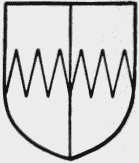
Bromley of Holt. Quarterly fessewise indented gules and or.
The 15th-century court rolls give an interesting record of the growth of inclosures; towards the end of the period several tenants were accused of encroaching on the common land almost as regularly as the court was held, (fn. 39) and in spite of fines the practice seems to have increased steadily. In 1387 the jurors presented that Geoffrey Binn had 'built a dovecot by his cottage to the damage of the whole community, wherefore he was commanded to pull it down.' (fn. 40)
There were two fisheries attached to the manor of Wick Episcopi in 1086, (fn. 41) and one followed the descent of the manor throughout. (fn. 42) The other passed by the grant of Bishop Giffard to the priory of Malvern, and has since the suppression of that house descended with the mills. It now belongs to Mr. Willis-Bund. (fn. 43) In 1348 the prior had also a fishery at Bedwardine. (fn. 44) A park at Wick belonging to the Bishop of Worcester is mentioned in 1339, (fn. 45) and free warren in the demesne lands there was granted to Walter Cantilupe by Henry III in 1254. (fn. 46)
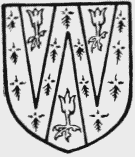
Bund. Ermine a pile gules from the foot between two like piles from the chief with an eagle's leg razed or upon each.
The manor of UPPER WICK (Goldhine Wic, xii cent.; Goldginewike, Goldinewyke, xiii cent.; Wyke Dabitot, Sapynswyk, Wick Sapey, Overwyke, xiv cent.; Weeke Sapi, Gowld Weeke, Upper Week, xvii cent.) is said to have been granted to Osbert D'Abitot by Bishop Alfred, probably about 1158 (fn. 47); it afterwards followed the descent of Redmarley D'Abitôt (q.v.) until 1389, (fn. 48) when it passed on the death of John de Sapy to Ellen de Arderne, who was perhaps his daughter and heir. (fn. 49) Her descendants, the owners of Pedmore (q.v. in Halfshire Hundred), remained in possession of the manor until 1563, (fn. 50) when it seems to have been sold by Edward Arderne to John Nanfan, (fn. 51) who sold it in 1571 (fn. 52) to Jasper Gower. Nine years later it was purchased of Jasper by John Hall (fn. 53) of Henwick. His son Edward demised part of the manor about 1614 to Paul Tracy of Stanway (co. Glouc.), bart., (fn. 54) and died seised of the remainder in 1617, leaving as his heir his son and namesake. (fn. 55) This Edward Hall together with Sir Paul Tracy conveyed the manor in 1633 to Henry Best, (fn. 56) whose only child Katherine was married before 1650 to Scudamore Pytts, the younger son of James Pytts of Kyre Wyard. (fn. 57) Henry Best was still living in 1669, when he was a party to the fine by which certain lands in Wick were settled on Katherine Cliffe, (fn. 58) afterwards the wife of his grandson James Pytts. (fn. 59) She seems to have lived here during her widowhood, (fn. 60) and died here, being buried in St. John's Church. Her heir was her son Samuel Pytts, then owner of Kyre Wyard, (fn. 61) and he sold the site of the manor and other land at Wick to Thomas Bund, whose great-grandson Mr. John W. Willis-Bund is now the owner. (fn. 62)
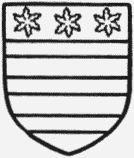
Pytts of Kyre. Azure three bars argent with three stars or in the chief.
According to the register of Worcester Priory the manor of HARDWICK (Hordewik, Herdewyk, Hardewik, xiii cent.; Hardeswyke, xvi cent.) was granted to the monks of that house by King Edgar between 961 and 975. (fn. 63) It is not, however, mentioned in the Domesday Survey, nor does there seem to be any reference to it earlier than 1236, at which date it certainly belonged to the priory. (fn. 64) In 1256 the monks obtained from Henry III a grant of free warren in their demesne lands there, (fn. 65) which was confirmed by Edward III in 1355. (fn. 66) The manor remained in the possession of the priory till the Dissolution, (fn. 67) when Henry VIII granted it to the dean and chapter. (fn. 68) During the Commonwealth it seems to have been occupied by John Oldbury, (fn. 69) who had obtained a long lease of it from Dean Potter in 1638, (fn. 70) but after the Restoration it was recovered by the dean and chapter.
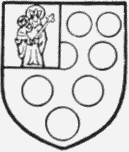
Worcester Priory. Argent ten roundels gules and a quarter azure with our Lady and the Child or therein.
A court baron was held there as late as 1857, (fn. 71) and there are still (1912) at least two copyhold tenants. (fn. 72)
In 1291 the proceeds from the manor of Hardwick, except the profits from stock, were assigned to the pittancer of the priory, (fn. 73) from which it may perhaps be concluded that PITTENSARYS FARM, for which there is no separate entry in the Taxation, was at that time regarded as a member of this manor. Its early history was, however, quite distinct from that of Hardwick, for there can be little doubt that this small estate, which contained rather more than 31 acres in 1860, (fn. 74) was the odd virgate of the bishop's demesne held by Urse D'Abitot at the time of the Domesday Survey. (fn. 75) This land, which had been held of Urse by his chaplain Alfred, (fn. 76) was granted by his son-in-law Walter de Beauchamp to the Priory of Worcester (fn. 77); it is described as being on the west side of the chapel of St. John, (fn. 78) and the 14th-century court rolls show that it stretched as far as the bridge called Hereford Bridge over Laughern Brook. (fn. 79) It followed the descent of Hardwick until 1860, (fn. 80) and though called a manor in the 16th century never seems to have had a separate court; it was, however, always leased to tenants as a separate estate by the dean and chapter. (fn. 81) In 1857 a lease for twenty-one years was granted by them to Mr. Francis Williams of Laughern Hill, (fn. 82) who enfranchised the estate in 1860. (fn. 83)
The manor of CROWN EAST (Crawenest, Crowe Nest, xiii cent.; Crowneast, xvii cent.) or RIDGE HALL (Rugge, xii cent.; Rughall, Ruggehall, xiv cent.; Rygehalhide, (fn. 84) Riggehallhide, xvi cent.) seems to have been a collection of holdings bought during the 13th century by Baldwin de Frevile and his son Alexander. One carucate of this land belonged in 1236 to Walter Bufle (fn. 85); his son and heir Robert sold it in 1255 to Baldwin de Frevile, (fn. 86) who settled it at the same time on himself and his wife Maud with remainder to their younger son Alexander. (fn. 87) Baldwin died shortly afterwards, (fn. 88) and before 1265 his widow had married Sir William Devereux, who was killed fighting for the king at Evesham. (fn. 89) Maud released her right in Crown East to her son Alexander before 1286, in which year he obtained from Edward I a grant of free warren in his demesne lands there. (fn. 90) These lands were said in 1349 to be held of the Prioress of White Nuns at Whistones. (fn. 91) Alexander seems also to have acquired before 1286 another virgate of land, which he held of the Bishop of Worcester in 'Rugge' in 1299 (fn. 92); it had been held of Bishop Baldwin about 1182 by William of St. John's. (fn. 93) A second virgate of land in 'Rugge' was added to the estate before 1349, either by Alexander or his son Baldwin (fn. 94); this was probably the virgate held of the bishop in 1299 by Thomas son of Walter le Fleming. (fn. 95) Alexander Frevile spent a great part of his long life in the king's service both in France and Scotland, (fn. 96) and it was perhaps as a reward that he received in 1305 a pardon of the debts due from him to the Exchequer. (fn. 97) He served in the Bannockburn campaign, (fn. 98) and was again summoned to march against the Scots in 1327, when he must have been at least seventythree. (fn. 99) He died in the following year and was succeeded by his son Baldwin, (fn. 100) who died seised of 'Croweneste and Rughall' in 1346, leaving as his heir his son and namesake. (fn. 101) This Baldwin Frevile, who was afterwards knighted, granted the manor to his cousin John Hillary alias Grey of Sandiacre (co. Derby). (fn. 102) John Grey died in 1403, leaving as his heirs his daughters Isabel, who married first John Walsh and afterwards Humphrey Halloughton, and Alice the wife of John Leeke. (fn. 103) Isabel died in March 1435, when the jurors presented that her son was of full age and might hold when he had satisfied his lord of his homage. (fn. 104) She had not, however, been living in the neighbourhood for some time, (fn. 105) and her son had presumably died before her, for by the inquisition taken in the following May her sister Alice was found to be her heir. (fn. 106)
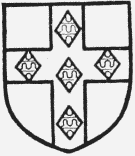
Frevile. Or a cross gules with five lozenges vair thereon.
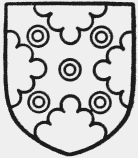
Leeke of Sandiacre. Argent a saltire engrailed sable with five rings or thereon.
Alice settled the manor on her younger son Thomas Leeke, who was seised of it in 1453, (fn. 107) and was apparently succeeded about 1459 by another Thomas Leeke, perhaps his son. (fn. 108) This Thomas may have been still living in 1472, as there is no mention of Crown East among the possessions of the Leekes of Sandiacre at that date (fn. 109); by 1513, however, the Worcest rshire manor seems to have reverted to the elder branch. (fn. 110) John Leeke of Sutton-en-le-Dale, the grandson of Alice's eldest son William, dealt with it in that year, (fn. 111) but it subsequently passed to his younger brother Thomas Leeke, who sold it in 1518 to John Mucklowe. (fn. 112)
William Mucklowe, John's heir, died in 1529 seised of the manor of Crown East, which he left by his will to Peter Mucklowe. (fn. 113) Peter was succeeded by William Mucklowe's eldes son Richard, who was seised of Crown East and Ridge Hall (described at this time as separate manors) at his death in 1556. (fn. 114) The estate afterwards followed the descent of Martley in Doddingtree Hundred (q.v.) until 1619, (fn. 115) when it was sold by Simon Mucklowe to Edmund White. (fn. 116)
Edmund White died in 1633, leaving the manor by will to his son Edmund, with successive remainders to Edmund's son and namesake and his heirs male and James White, the testator's son. (fn. 117) In 1676 the third Edmund White sold Crown East, with the consent of his cousin and heir-apparent John the son of James White, to Edward Barton, (fn. 118) who dealt with it by fine in 1704. (fn. 119) The descent of the manor after this date is not easy to trace, but as Nash states that the family of John Wowen, owner of the estate in 1801, had held it for nearly 150 years, (fn. 120) Wowen was perhaps descended from Barton. His father, another John Wowen, was in possession in 1765, (fn. 121) but the history of the manor during the first half of the 18th century is obscure. The Wowens had considerable property in the parish. It was, however, sold to various persons about 1820. The largest lot, Crown East, with about 300 acres of land, was bought by Josiah Patrick. It passed from him to a solicitor in Worcester named Hughes, who sold it about 1860 to A. H. Royds. At his death it was sold to the present owner, Mr. Henry Bramwell, J.P. (fn. 122)
According to the chartulary of Worcester Monastery half a hide of land at LAUGHERN (Lawerne, x cent.; Laure, xi cent.; Lauwern, Lauerne, xii cent.; Lawerne Almoners, Lawerne Elemosinary, xv cent.) was granted by Offa, King of the Mercians, to Bishop Heathored between 781 and 796, (fn. 123) and bestowed on the prior and convent by Bishop Cynewold before 957. (fn. 124) In the time of King Edward the Confessor Kineward held it, 'doing such service as the bishop willed.' (fn. 125) The monastic chartulary states that it had been held by him of the convent, and reverted to the monks at his death, (fn. 126) but they were deprived of it shortly afterwards by Robert le Despenser, (fn. 127) who held it at the time of the Domesday Survey. (fn. 128) Between 1108 and 1118 (fn. 129) it was held by Nicholas, (fn. 130) probably of Walter de Beauchamp, whose son William de Beauchamp was in possession of it before 1180. (fn. 131)
In 1299 the Prior of Worcester held half a hide in Laughern by service of a quarter of a knight's fee (fn. 132); this seems to have been the same estate and was probably the land granted by John D'Abitot (living 1197) (fn. 133) to the priory. (fn. 134) Among the property of the prior taxed in 1291 were certain lands in 'Lawerne debetok' (? D'Abitot) held by the almoner, (fn. 135) and the monks paid a rent of 2 marks yearly to the heirs of Lord Beauchamp as late as 1536. (fn. 136) 'The Almoner's manor in Lawerne' is mentioned in the 14th-century court rolls, (fn. 137) but at a later date it probably lapsed; it is not mentioned by name in the priory accounts of the 16th century, (fn. 138) or in the Valor, (fn. 139) though it was evidently included at this time among the priory lands in Hardwick and St. John's. (fn. 140)
TEMPLE LAUGHERN (Lauwerne, xii cent.; Lauuarne, Lawerne Willelmi, xiii cent.; Temple Lauherne, Holberie Lawerne, xv cent.; Temple Lawghern, xvi cent.; Holberie, Templars Lawerne, xvii cent.).
According to the chartulary of Worcester Priory a manor in Laughern was 'returned' to the cathedral monks by Bishop Simon between 1125 and 1151, (fn. 141) but, as both the manors mentioned in Domesday Book were still held at that date by William de Beauchamp, (fn. 142) this was probably a fresh grant from the bishop's demesne. It seems to have been this property which the prior and convent afterwards claimed to have granted to William the son of Miles de Laughern before 1236 at a yearly rent of half a mark. (fn. 143) William was succeeded by another Miles, who sold the manor in 1249 to the Master and brethren of the Temple for £100. (fn. 144)
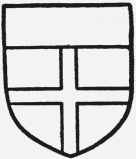
The Knights Templars. Argent a cross gules and a chief sable.
In 1253 the Templars received from Henry III a grant of free warren in their demesne lands in Laughern, (fn. 145) but after the death of Miles their right to their property was disputed by his sister and heir Sabine and her husband John de Donyngton, who occupied the manor, (fn. 146) and it was not until 1275 that the master obtained a quitclaim from them, promising in return to pay a rent of 8 marks yearly during the lives of John and Sabine. (fn. 147) To this settlement the Prior of Worcester opposed his claim, (fn. 148) but though he was unsuccessful the Templars were not yet able to enjoy their manor in peace, as the Donyngtons re-entered during 1276, (fn. 149) and the new master was obliged to come to terms with them in the autumn of that year. (fn. 150)
The Templars remained in possession of the manor till 1311, (fn. 151) when it was granted on the fall of the order with the Preceptory of Balsall, to which it had become attached, to the Knights Hospitallers, (fn. 152) who retained it till the Dissolution. (fn. 153) In 1544 it was sold by Henry VIII to Richard Goodyere and William Gower. (fn. 154) In 1558 Richard Goodyere obtained licence to alienate his moiety of the manor to Roger Goodyere alias Onyon, (fn. 155) who in 1583 settled certain lands there on his son Richard Onyon alias Unwyn, retaining the rest of the property to his own use for life. (fn. 156) Roger was succeeded in 1611 by his son Richard, (fn. 157) who together with Roger his son sold much of the land to John Gower, the owner of the other moiety of the manor. (fn. 158) The descent of Unwyn's own share after this date is difficult to trace; it was held in 1629 by Robert Stanford, who left it at his death to his daughter Frances the wife of George Middlemore. (fn. 159) By 1655 some of the land seems to have come into the possession of Francis Earl of Shrewsbury, (fn. 160) and this had passed before 1679 to Jane Cotes, who with her son Henry Cotes conveyed it in that year to Sir Edward Sebright, bart. (fn. 161) The so-called manor was settled on Richard Sebright, Sir Edward's younger son, in 1707, (fn. 162) but its history after this date is obscure.
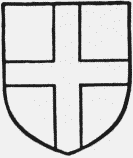
The Knights Hospitallers. Gules a cross argent.
William Gower, who bought the second moiety of Temple Laughern in 1544, was also the owner of Boughton or Boulton (q.v. infra), and his property in Laughern afterwards became known as the manor of Boulton Colemarsh. (fn. 163) It followed the descent of Queenhill in Ripple (fn. 164) (q.v.), and was still held by the Gower family in 1766. (fn. 165) They sold it early in the 19th century to the Harrisons, who held it till about 1840, when it was sold to the Munns. On the death of the last brother about 1900 it was bought by James Best, whose widow now lives there. (fn. 166)
In 1086 Urse D'Abitot held 3 virgates at LAUGHERN (Laure, xi cent.; Lawerne, xii cent.; Lauerne, Lawarne Dabtot, Bechameslawerne, xiv cent.; Lawarne Beuchamp, xv cent.; Lawgherne, xvi cent.) which had previously been held by Sawine as of the bishop's demesne. (fn. 167) This was afterwards held of William de Beauchamp by John D'Abitot (fn. 168) and followed the descent of Hindlip (q.v.) until 1286, (fn. 169) when it was resumed by the Earl of Warwick, who settled it on his third son Walter. (fn. 170) In 1300 Walter de Beauchampobtained a grant of free warren in his demesne lands in Laughern. (fn. 171) By 1346 the estate had passed to William de Beauchamp, Walter's second son, who settled it in that year on himself and the heirs of his body with successive remainders to William de Bradewell and his own right heirs. (fn. 172) Before 1379 the rents issuing thence were in the possession of Sir Roger Beauchamp, who is said to have been a younger son of Giles Beauchamp of Powick. (fn. 173) Sir Roger died in 1379, leaving as his heir his grandson Roger, then sixteen. (fn. 174) John Beauchamp, the grandson of the younger Roger, died during his minority, leaving as his heir his sister Margaret. (fn. 175) She married Oliver St. John, who was seised of the manor of Laughern Beauchamp in 1431. (fn. 176) They had several sons, but the manor passed by settlement or purchase to their cousin Richard Lord Beauchamp of Powick, who settled it on his daughter Margaret and William Rede on their marriage. (fn. 177) Margaret predeceased her husband, who died in 1508 seised of the manor. (fn. 178) His heir was his son Richard Rede, (fn. 179) whose wardship and marriage were granted to his uncle Richard Lygon. (fn. 180) Richard Rede died before 1544, leaving a widow Joan, who held the estate for her life. (fn. 181) William Rede, Richard's heir, conveyed the reversion to Thomas Solley and other trustees in 1544, (fn. 182) but the descent of the manor after this date is obscure. Some of the land seems to have been bought by the owners of Earl's Court (q.v. infra), and may have formed the so-called manor of Laughern Grove (fn. 183); the rest perhaps passed to the Dean and Chapter of Worcester.
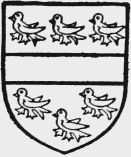
Beauchamp of Powick. Gules a fesse and six martlets or.
The reputed manor of LAUGHERN GROVE or THE GROVE is first mentioned in 1564, and seems to have derived its name from the 20 acres of woodland which had previously formed part of the manor of Laughern Dabitot (fn. 184); the part of the property to the south side of the Bransford road had probably been bought by John Bund, whose family had held it of the Bishops of Worcester as parcel of the manor of Wick at least as early as 1457, (fn. 185) and in whose descendant Mr. J. W. Willis-Bund it still remains. (fn. 186) In 1546 John Bund alias Walcrofte and William Gower were parties to a fine concerning this part, (fn. 187) and by 1616 the estate had acquired the alternative name of Bunde Grove. (fn. 188) The other part on the north side of the Bransford road was held in that year by William Ingram of Earl's Court (fn. 189) (q.v. infra), and subsequently followed the descent of that property. (fn. 190)
The reputed manor of EARL'S COURT seems to have been a collection of holdings bought by Arnold Gower before 1542 and settled by him in that year on his illegitimate son John Gower, (fn. 191) who afterwards conveyed the estate to Arnold and his wife Eleanor for their lives. (fn. 192) John Gower died before 1559 (fn. 193) and was succeeded by his son John, who died childless, leaving as his heir his sister Elizabeth the wife of Richard Ingram. (fn. 194) Elizabeth's right to the property was disputed about 1561 by William Gower, the grandson of Arnold's brother and heir William, (fn. 195) but in 1599 she and her son William Ingram succeeded in obtaining a quitclaim. (fn. 196)
Henry Ingram, the son of William, succeeded before 1637 (fn. 197); he mortgaged his property in that year to Richard Briggenshawe, who entered in default of payment in 1639, though he is said not to have paid the extra money agreed upon for the absolute purchase, (fn. 198) and conveyed it in trust to his son William Briggenshawe. (fn. 199) But Timothy Colles, who had married Margaret the daughter of Henry Ingram, expressed himself willing to redeem the estate and complained that Ingram and Briggenshawe prevented him. (fn. 200) The descent of the reputed manor after 1649 is not clear. Sara the daughter and heir of Timothy Colles married Thomas Geers, (fn. 201) and Eleanor the daughter of William Briggenshawe became the wife of Francis Geers, (fn. 202) who dealt by fine with Earl's Court in 1691 (fn. 203); the estate does not, however, seem to have been in the possession of the heirs of either. Thomas Geers married as his second wife Elizabeth the widow of Robert Whitney, (fn. 204) and her grandson Edward Cope Hopton was the owner of the property in 1745 (fn. 205); it afterwards descended with Iccomb (q.v.) to the Rev. John Parsons, afterwards Hopton. (fn. 206) On the death of his son and successor John in 1891 the estate passed to the latter's daughter Bertha Maria wife of Walter Thomas Mynors Baskerville of Clyro Court, Radnorshire. She died in 1892, and her daughter Sybil Maud is now the owner of Earl's Court. Sybil Maud Baskerville assumed the name Hopton in 1898, and Colonel John Dutton Hunt, whom she married in the following year, also took the name Hopton. (fn. 207)
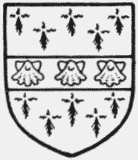
Ingram. Ermine a fesse gules with three scallops or thereon.
BOUGHTON or BOULTON originally belonged to the manor of Wick Episcopi. (fn. 208) William de Pechesleye had tenements there in 1345 of the gift of Alexander vicar of Hallow and Richard de Hindlip, chaplain, (fn. 209) and William de Habington held lands in the neighbourhood about 1431. (fn. 210) At about the end of the 15th century John Gower of Suckley, second son of Thomas Gower of Woodhall by Catherine daughter of John Lord Dudley, (fn. 211) bought lands here, and, in the words of Habington, built 'a faire house at Boulton.' (fn. 212) Several adjoining holdings were bought during the 16th century by Arnold and William Gower, sons of John Gower, (fn. 213) and William Gower eventually succeeded to the whole estate, (fn. 214) which was afterwards termed a manor. William Gower died in 1546, (fn. 215) and it then passed to his son Henry Gower, (fn. 216) who sold it in 1617 to his cousin Abel Gower, son of George Gower of Colemarsh. (fn. 217) Abel Gower was succeeded in 1632 by his eldest son Abel, (fn. 218) who died in 1669. (fn. 219) He was succeeded by his eldest son Robert Gower, who married Catherine daughter of Sir William Childe of Kinlet, co. Salop, (fn. 220) and, dying in 1689, (fn. 221) was succeeded by his eldest son Abel Gower, (fn. 222) who died in 1710, having two sons Abel Eustace and William Gower, both minors. (fn. 223) Abel Eustace Gower dying some few months after his father, the estate passed to his brother William Gower. (fn. 224) John Gower of Queenhill was dealing with the manor of Boughton in 1719. (fn. 225) The manor was sold in 1729 by William Gower, then of Chiddingstone, co. Kent, to Joseph Weston, a merchant of Worcester. (fn. 226)
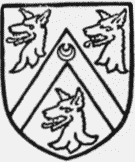
Gower of Suckley. Argent a cheveron between three wolves' heads razed gules with the difference of a crescent.
In 1778 Mary Weston, Joseph's widow, and her son Joseph sold a portion of the estate to William Lilley (fn. 227) and the remainder to Thomas Bund. The Rev. John Lilley, son of William, sold part of the land in 1810 to Mr. Elias Isaac (fn. 228); the remainder with the reputed manor he had already sold in 1808 to Mr. Joseph Helm, (fn. 229) from whom Mr. Elias Isaac bought it in 1814. (fn. 230) The present owner is his great-grandson Mr. Arthur W. Isaac.
Two mills in Wick were attached to the bishop's manor in 1086 (fn. 231); these seem to have been Wick Mill on the Teme and Cut Mill (Cottemulne, Cuttemill, xiii cent.; Cuttenmill, xiv cent.) on Laughern Brook, both of which followed the descent of Wick Episcopi till the end of the 13th century. (fn. 232) About that time another mill was built on the Teme, (fn. 233) and in 1300 Giffard granted all three to the Prior of Great Malvern. (fn. 234)
In 1475 the tenants in Wick Episcopi complained that the prior had dug a canal from the Teme to Wick Mills, greatly to the damage of their land, (fn. 235) and that he had not paid the yearly sum agreed on before he had obtained leave to do this, or repaired the bridge over the water as he had promised. (fn. 236) In 1536 the prior paid 4s. rent for his water-course and held the mills (Powick Mill and Cut Mill), valued at £5 4s. 8d. yearly, at a fee-farm rent of £4 0s. 8d. to the bishop. (fn. 237) In 1543 the two water-mills called Powick Mills in the tenure of William Moore were granted to Richard Andrews and Nicholas Temple, (fn. 238) who had licence to alienate them to William Moore in the same year. (fn. 239) He died in 1565 seised of three water-mills called Powick Mills, (fn. 240) and his son Richard sold two of them in 1578 to William and Anthony Gower. (fn. 241) The reversion of two mills at Wick was granted by Queen Elizabeth to Sir Thomas Bromley in 1586, (fn. 242) and they afterwards passed with part of the manor of Wick Episcopi to William Bund. (fn. 243) Three mills at Wick were sold by Mr. J. W. Willis-Bund in 1904 to the City of Worcester, and are now their electricity works. (fn. 244) Cut Mill seems to have been one of those sold by Richard Moore to William Gower in 1578, (fn. 245) and afterwards followed the descent of Boughton, (fn. 246) until it was sold about 1760 by Mary Weston to William Bund. The mill was then pulled down and the mill-pond filled up. About 1780 Thomas Bund redeemed the quit-rent payable from it to the Crown. (fn. 247) With Cut Mill William Gower also acquired another water-mill, (fn. 248) which like Cut Mill followed the descent of Boughton till 1693, (fn. 249) but no mention of it occurs after this date.
The New Mill in Laughern D'Abitot was probably the mill that formed part of that manor in 1086. (fn. 250) It was granted before 1294 to the cathedral monastery (fn. 251) and probably descended to the dean and chapter. (fn. 252) It seems to have been on the site of St. John's Mill; the court rolls show that it stood on a high road near a bridge close to the borders of Laughern D'Abitot and the Pittensarys. (fn. 253) St. John's Mill, on the Bromyard road, is now the Worcester Cold Storage Works.
Ambrose Mill (Aumbreyesmille, Awmbreys, xiv cent.) was perhaps part of the tenement in Laughern granted to the Prior and convent of Worcester by John son and heir of Geoffrey Ambrose. (fn. 254) After the Dissolution it came into the possession of the dean and chapter. (fn. 255) It still exists on the road from Worcester to Dines Green.
Wandesford Mill is first mentioned in 1236 (fn. 256); it was situated in the same tithing as the New Mill and Ambrose Mill, (fn. 257) and like them paid tithes to Worcester Priory. (fn. 258) It is last mentioned by name in 1392, (fn. 259) but may have been one of the three unnamed mills belonging to the dean and chapter after 1630. (fn. 260)
A water-mill called Ivall's Mill is mentioned in 1630, when it was occupied by George Worfield (fn. 261); it had previously been held by William Worfield and Michael Worfield, (fn. 262) and was afterwards apparently in the possession of the dean and chapter. (fn. 263) Another water-mill was attached to the manor of Earl's Court in 1647. (fn. 264)
A windmill outside Hardwick is mentioned in 1236, when it belonged to the priory of Worcester. (fn. 265) It was perhaps this mill which was 'removed from its place by means of Mr. Richard Cupper' about 1626, (fn. 266) and set up on some copyhold lands in the manor of Wick Episcopi. (fn. 267) No further mention of it occurs.
CHURCH
The church of ST. JOHN BAPTIST in Bedwardine consists of chancel with south chapel, nave with south aisle and a western tower, with a wide north aisle of modern work. The north arcade of three bays is of the 12th century, but the arches were destroyed some years ago, so as to give more view from the pulpit. The south arcade is of the 14th century, and the south wall has two large windows under gables of which the eastern represents the transept. On a pillar of the south arcade is a shield with the Gower arms. The south chapel of the chancel is of the 14th century with the original roof. (fn. 268) The font is modern. There is a good monument in the north aisle, and there are several monuments to the Bund family, which with others have been moved from their original positions when the church was restored and the chancel built about twenty years ago. At the same time some old glass in the east window was taken out and worked up in the chancel windows. The parish chest of 1693 is plain with iron straps.
The 15th-century tower at the west end is wide and low and contains a ring of six bells by Thomas Mears of London, dated 1816 (the second 1815), also a small bell by John Greene, a Worcester founder, dated 1626. The former bells were by Richard Sanders of Bromsgrove, 1707.
The plate consists of an Elizabethan flagon, a cup and cover for paten of 1571, a paten of rude work and inscribed 'The gift of G. Wryfall, 1736.' There are also a cup, cover and flagon of recent date. (fn. 269)
The registers before 1812 are as follows: (i) baptisms and burials 1558 to 1774, marriages 1559 to 1754; (ii) baptisms and burials 1775 to 1812; (iii) marriages 1754 to 1812. All are in good condition. (fn. 270)
ADVOWSON
The church of St. John the Baptist in Bedwardine was originally a chapel of ease to the church of St. Cuthbert, Wick Episcopi. St. Cuthbert had in its turn been a chapelry attached to the church of St. Helen, Worcester, and as such had been granted by Fritheric to the monks of Worcester Priory, according to their chartulary, in the 12th century. (fn. 271) William of Blois, however, seems to have disputed the right of the convent to the chapelries belonging to St. Helen, for in 1234 he made an agreement with them by which they should hold only those of Wick and Wichenford. (fn. 272)
Wick was still a chapelry in 1236, (fn. 273) and seems to have been appropriated about this time to the Prior and convent of Worcester together with the chapels of St. John, Golden Wick and Laughern. (fn. 274) The chapel of St. Cuthbert at Wick became the parish church before 1283, (fn. 275) though the vicarage-house was always at St. John's. (fn. 276)
It is not clear when the chapel in St. John's began to be more important than the mother church; possibly an increase in the population of the suburb and the duties of its vicar led to Bishop Giffard's suggestion in 1283 that his work was underpaid. (fn. 277) This was also the opinion of William Lynn, bishop in 1370, who stated that the prior and chapter took so large a proportion of the tithes that there was not enough left to support a separate vicar at all. (fn. 278) He therefore determined, at the request of the parishioners, to abandon the church of Wick, which was already 'half deserted and attended by very few,' and make St. John's Chapel the parish church. (fn. 279) The new church was consecrated in 1371. (fn. 280)
The advowson belonged to the priory till the Dissolution, (fn. 281) and was granted in 1542 to the Dean and Chapter of Worcester, (fn. 282) who are still the patrons. (fn. 283)
The chapels of Golden Wick and Laughern are mentioned in 1236. (fn. 284) These were both private chapels belonging to the lords of those manors, who paid a certain sum yearly to the priory for leave to hear divine service. (fn. 285) The latter chapel was at Laughern Willelmi, (fn. 286) and probably fell into disuse after the estate was granted to the Templars The chapel at Golden Wick is not separately mentioned after this date. Another chapel was attached to the manor of Crown East; in 1256 Maud de Frevile founded a chantry there for the health of her husband's soul. (fn. 287) The licence for this chantry was to last only during her life, (fn. 288) and probably after her death the chapel too was disused, as her son cannot have spent much time there, and the manor-house itself was a ruin in 1349. (fn. 289) There was also a private chapel belonging to the bishop's house at Wick. (fn. 290)
CHARITIES
The United Charity School was founded by deeds of Milberrow Doelittle, 1719, and Mercy Herbert, 1722. (fn. 291)
In 1852 Mary Harrison, by her will proved 19 May, left £50 for the benefit of the Sunday school. The legacy is on deposit in the Post Office Savings Bank; the income of £1 5s. yearly is applied to the Sunday schools.
The charities of John Carwardine and others are now represented by £508 9s. 6d. consols with the official trustees, arising from the sale in 1904 of certain lands and hereditaments comprised in deeds of lease and release 4 and 5 November 1719. These had been purchased with sums given by several charitable persons for the use of the poor. The annual dividends, amounting to £12 14s., are applied as to £1 in the distribution of Bibles in respect of a gift of £20 by Margery Carwardine for that purpose, as to £5 in the distribution of bread on St. Thomas's Day, and the residue towards repairs of the church.
This parish participates in the general charity of Henry Smith. In 1909 £12 12s. was received and applied in the distribution of twenty-four gowns and in bread to the value of £2 10s.
In 1698 Timothy Nourse by his will devised an annuity of £25 for binding poor children as apprentices and for clothing poor old men and women. The annuity was redeemed in 1866 by the transfer to the official trustees of £833 10s. consols, now producing £20 18s. 6d. yearly, which is applied chiefly in the distribution of coats and in subscriptions to the clothing club.
In 1701 Henry Johnson by his will devised 3 r. of land, the rents to be distributed equally among twelve poor widows. The land was sold in 1874 and the proceeds invested in £162 12s. consols with the official trustees. In 1877 a sum of £78 14s. 10d. consols was sold out and the proceeds remitted to the trustees, leaving a sum of £83 17s. 2d. with the official trustees, producing £2 1s. 8d. yearly.
In 1880 Mrs. Janet Amelia Meredith, by her will proved at London 13 May, bequeathed £300 in augmentation of one or more of the parochial charities. The legacy was invested in £303 0s. 7d. consols, producing £7 11s. 4d. yearly.
The Church Lands.
—The parish has from time immemorial been in possession of certain lands and hereditaments for the repairs of the church and such other godly uses as the major part of the parishioners approve, the earliest deed extant being dated in 1640. In 1910 the gross income, including the dividends on a sum of £113 12s. 9d. consols with the official trustees arising from the sale of a cottage and garden at Dines Green, exceeded £200.
